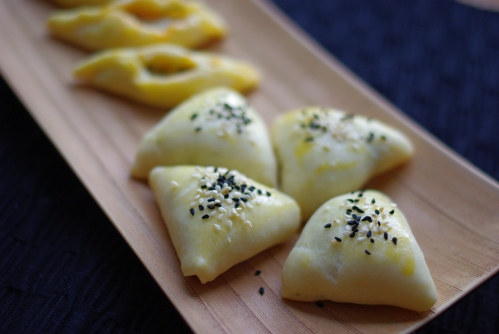Halloween is here and pumpkins are everywhere, in supermarkets, on TV, and all over the blogosphere!
I am one of the people who gets irritated by Halloween for some reason, I don't know. May be the commercial nature to Halloween celebrations. May be I feel Americans are ramming their Halloween down our throats. May be ... I don't know. It just irritates me!
So the last thing I expected myself to do is to post a Halloween special, but all these nice recipes (here, here and here) got me inspired. I haven't cooked pumpkin in years and I really fancied some. So I decided to cook Tahini Pumpkin (yaqteen bi thineh يقطين بطحينة in Arabic)
Pumpkin in Syria is traditionally cooked in tahini sauce. A nice hearty stew perfect for a cold winter night. The tahini in this dish is added towards the end and cooked with the meat and pumpkin. Although the flavours are great, tahini curdles in high temperature and the dish doesn't look that great. I prefer to make a loose tahini sauce and pour it on the dish just before serving. It looks much nicer!
A much lighter variation on this dish omit tahini all together and replace it with garlic yoghurt sauce. This is my favourite way to cook pumpkin and I will post the recipe soon.
Here is my Tahini Pumpkin recipe:
Lamb cubes 400g
Small pumpkin
Onion
Chicken stock 250mls (or a stock cube)
Walnut 75g
Tahini 5tbsp
Garlic one clove
Lemon
Salt
Pepper
Allspice 1/2tsp
Ghee clarified butter 1tbsp (alternatively use olive or vegetable oil)
In a heavy bottom pot, brown the meat in the Ghee butter and remove from the pot. Add the sliced onion and cook on medium heat till soft. Peel and de-seed the pumpkin and cut into chunky pieces. Add to the pot and fry for few minutes. Add the browned meat, allspice, chicken stock, salt and pepper to taste. Crush the walnuts in a pestle and mortar and add. Stir the ingredients and add hot water if necessary to cover. Bring to boil then reduce the heat to a simmer. Cover and cook for one and half hour or till the meat is tender. Try not to stir during cooking to avoid breaking the pumpkin.
In a bowl, wisk the tahini, salt, juice of half a lemon and very little water. The mixture will become light in colour and very stiff. Add more water and wisk. Keep adding water till the mixture start to soften and you reach a nice smooth consistency. The sauce need to be runny but not too watery.
When the pumpkin stew is cooked transfer to a deep dish and pour the tahini sauce. Decorate with some walnuts.
Serve with vermicelli rice.










